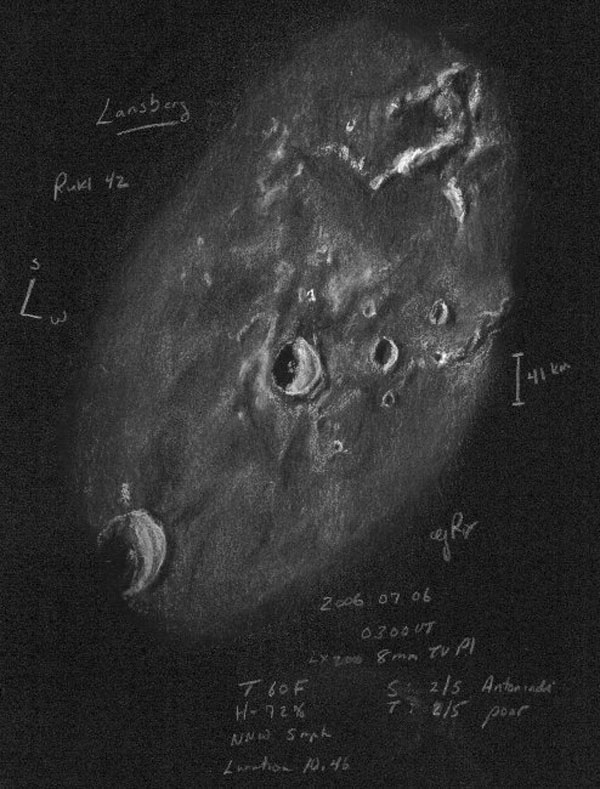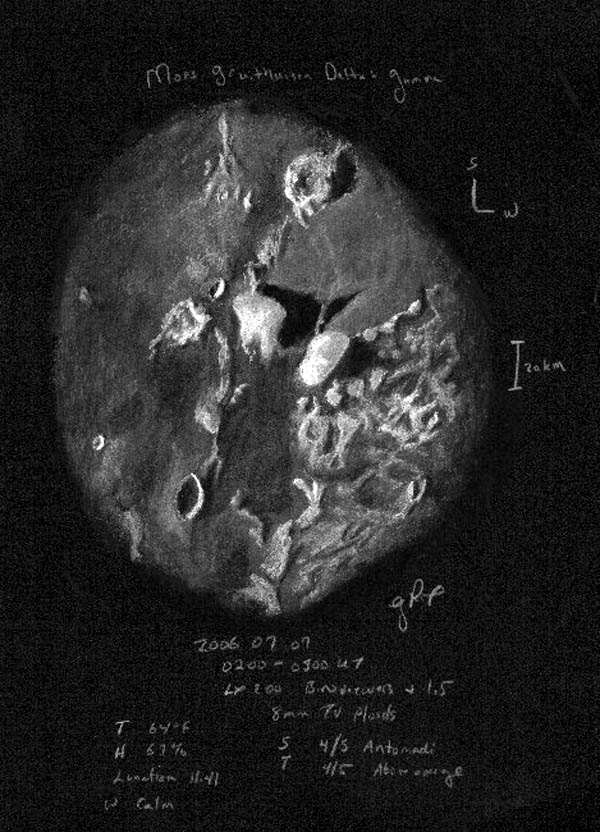2006 07 07
Lansberg/Gamma and Delta
“Wednesday night (Thursday for UT), was a practice session for imaging with my
Rebel. I finally bought a t-ring adaptor during a star party a few weeks ago and
had some fun playing with the new toy. The guys in the DSLR forum are giving me some
great pointers. Feels very strange entering that realm, but I have a feeling it
will compliment the sketching well for my observations. Plus gives me yet another
way to enjoy this hobby to the fullest!
It was then time to put the camera away and dig out my sketch kit. Paul, being the
thoughtful husband that he is, bought Tom L’s binoviewers for me last month. Tom,
if you’re reading this, I absolutely LOVE them! Wow! Thank you both so much!!!
I’ve been having a lot of fun with black Strathmore paper and Conte’ crayons for my
solar work, so with Rich in mind, I got up the nerve to try my first lunar sketch
with this media. Lansberg and the surrounding craters were my main targets that
night. I explored the terminator, tried to count craterlets in Plato, and admired
Copernicus (and was tempted to try it again, as the last time I tried to sketch that
beauty, my sketch was cut short and it was never completed).
Lansberg is from the Imbrian period and is about 41km. The central mountains stuck
out like two eyeballs in a dark room and I was pleased to see some terracing. All
the little craterlets around Lansberg belong to it with Kunowsky D being the
exception to the NW. Reinhold is trying to slip into the scene to the NE, but got
its toe stuck in the door. Montes Riphaeus was very dramatic, or at least compared
to the rest of the scene in that area.
After a great day today, which included solar observing (boy, that sun feels
great!), I set up with the binoviewers again tonight. Although seeing was poor, I
went ahead and bumped up magnification with 8mm TV Plossls (love that EP so much, I
had to get another one!). It was good enough to support the level of detail needed
to observe domes. Had I wanted to jump into a few complex craters, I believe a 20mm
would have been best. So, domes it was and why not a pair? Mons Gruithuisen Delta
and Gamma were flagging me down and I just could not resist.
They are also from the Imbrian period and close to 20km each. Looking at VMA, Delta
is classified as a mountain and Gamma is a dome. Rukl calls both of them a domelike
mountain massif. Hmmm, let’s see what Chuck Woods has to say about them. Aha! He
calls them domes, most likely formed of silicic volcanic rocks. For more reading on
this, see The Modern Moon, page 37. I would love to be one of the geologists that
Chuck suggests may someday bang on the domes with their rock hammers to see what
they are made of.
It was a bit disappointing that I didn’t see the summit crater on Gamma, but there
was an obvious darkened area on the western top portion of it. I loved buzzing
around in the all the little dips and valleys to the north of it, though. The
little raised line between Gamma and Gruithuisen K looked like a pea pod. Isn’t the
lava covered floor beautiful in that region?”
Sketches done with black Strathmore Artagain paper and white Conte’ crayons
Erika Rix
Zanesville, Ohio



Well, what can you say?
It’s simply Erika drawing! 🙂
Sebastian
Erika,
These sketches are awesome. The domes in the second sketch just pop out of my screen.